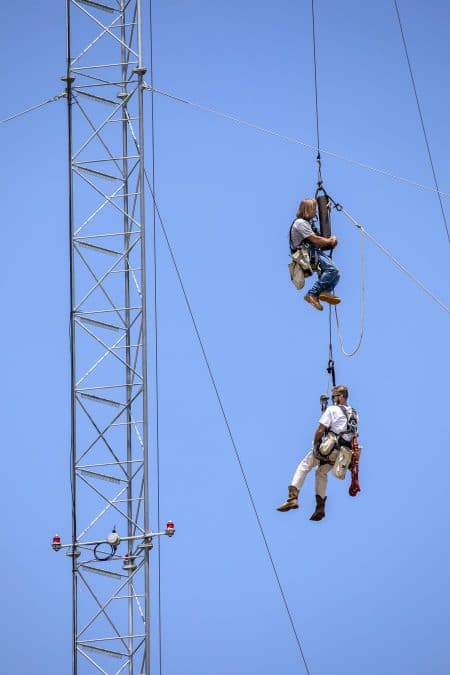One day in November 2019, Citizen Potawatomi Nation Emergency Communication Specialist Jody Opel, Emergency Management Director Tim Zientek and firefighters from the McLoud Fire Department piled into their cars and took off in different directions across Pottawatomie County. Their mission was to check the reliability of the Tribe’s new emergency communications tower.
“We were bound and determined to find any dead spots that there might be in the area that the tower wasn’t reaching,” said Rhett Banks, Fire Chief for the City of McLoud. They kept in contact for as long and as far as possible.
“We had communication in every section of our part of the county,” he said.
Banks has experienced radio and connection issues since he joined the department in 2005. The dead spots in its 66-square-mile jurisdiction put an undue burden on first responders.
“We would hit those spots regularly in our county, especially in the low-lying areas where we’d have a lot of vehicle accidents, those types of things,” Banks said. “So, it would be challenging at times when you’re out on a scene trying to communicate with your dispatcher or other units responding to that scene or your ambulance service.”

The small community of approximately 4,600 people is one of many rural towns across Oklahoma with the same difficulties. Zientek said the upgrade located near the FireLake Express Grocery store in McLoud was a necessity for public safety and emergency personnel.
“If they roll out to a scene and lose connectivity and can’t talk back to dispatch, and there’s some type of event happens to them where they’re may be stuck in the mud, or there are shots fired, there’s additional resources needed, and they can’t call back, then that poses a threat to their life,” he said.
Long time coming
The lengthy process of building and activating the McLoud communications tower began spring 2013 when a tornado wiped out the Steelman Estates mobile home park near Bethel Acres, Oklahoma. While dispatching to emergencies following the storm, first responders’ communications with one another overloaded the network, causing it to crash.
“That prompted CPN to, in our unique position as a Tribal government, to go after federal funding to establish an entirely new system that was 100 percent state of the art, but still interoperable, where … the old system and the new system could function together in unison,” Zientek said.
CPN applied for the Tribal Homeland Security Grant Program from the Federal Emergency Management Agency and received funding in 2014, 2018 and 2019 for a total of approximately $2.4 million. The Tribe paid the additional costs to serve Pottawatomie County and took steps each year to move the process forward.
“Tim (Zientek) always tells me, ‘It’s about improving it for everybody.’ I said, ‘Yes, sir,’” Banks said. “It’s a great partnership. I’m very proud to be a part of it.”
CPN finished building the tower in August 2019 and began testing it for errors and coverage in October of the same year. After more than five years, Zientek says he is starting to “see an end in sight.”
Coverage and cost efficiency
Geographically, the City of McLoud has areas of lower ground, one between two housing editions, and in the past, weak signals left it as a dead spot. The new tower bridges the area and provides clear audio.
“(CPN) put a lot of thought into it and was able to build it in a place in our community that would reach out to those low-lying areas and build it tall enough to where it would reach those low-lying areas,” Banks said.
Bethel Acres also switched to the new system after remaining on an older one until the tower’s completion.
“They have radio coverage now where they’ve never had radio coverage, even inside their fire station,” Zientek said. “Walked into their fire station with a handheld radio, and I could talk where, before the tower at McLoud came online, they had to go outside to talk.”
The new tower covers the northern section of Pottawatomie County, including the Grand Casino Hotel & Resort, and reaches north into Lincoln County and the three counties south of the South Canadian River. It goes as far as portions of Murray County, a distance of approximately 70 miles.
“It throws a signal a very long distance, and it’s digital. So, it’s crystal clear. You either have it, or you don’t. There’s no static,” Zientek said. “I’ve been as far south as Arbuckle Mountains (approximately 90 miles) and talked to dispatch, and that was just with the one tower.”
The type of implemented system also uses a LTE signal in addition to traditional bandwidth. Its large capacity gives it the ability to handle the signal traffic that comes with a major disaster. Dispatchers quickly move between various technologies at the Pottawatomie County 911 Dispatching Center, and new compatible equipment for vehicles and personnel costs less for the new system than the previous one. It is the first of its kind in Oklahoma.
“It’s rewarding, but it isn’t about that. It’s about protecting the people and property,” Zientek said. “Yes, it’s kind of neat that they’re looking at us and allowing us to go ahead and build out our system, and then, ‘Well, that’s working pretty good. We should do that.’ But CPN has always been that way. We kind of like to pave the way and break the ground.”
